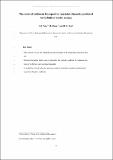The onset of sediment transport in vegetated channels predicted by turbulent kinetic energy
Author(s)
Yang, J. Q.; Chung, H.; Nepf, Heidi; Yang, Qingjun; Chung, Hayoon; Nepf, Heidi; ... Show more Show less
DownloadYang_Nepf_Final_manuscript.pdf (632.4Kb)
OPEN_ACCESS_POLICY
Open Access Policy
Creative Commons Attribution-Noncommercial-Share Alike
Terms of use
Metadata
Show full item recordAbstract
This laboratory study advances our understanding of sediment transport in vegetated regions, by describing the impact of stem density on the critical velocity, Ucrit, at which sediment motion is initiated. Sparse emergent vegetation was modeled with rigid cylinders arranged in staggered arrays of different stem densities. The sediment transport rate, Qs, was measured over a range of current speeds using digital imaging, and the critical velocity was selected as the condition at which the magnitude of Qs crossed the noise threshold. For both grain sizes considered here (0.6–0.85 mm and 1.7–2 mm), Ucrit decreased with increasing stem density. This dependence can be explained by a threshold condition based on turbulent kinetic energy, kt, suggesting that near-bed turbulence intensity may be a more important control than bed shear stress on the initiation of sediment motion. The turbulent kinetic energy model unified the bare bed and vegetated channel measurements.
Date issued
2016-11Department
Massachusetts Institute of Technology. Department of Civil and Environmental EngineeringJournal
Geophysical Research Letters
Publisher
American Geophysical Union (AGU)/Wiley
Citation
Yang, J. Q., H. Chung, and H. M. Nepf. "The onset of sediment transport in vegetated channels predicted by turbulent kinetic energy." Geophysical Research Letters, Early View article (12 November 2016).
Version: Author's final manuscript
ISSN
00948276
1944-8007